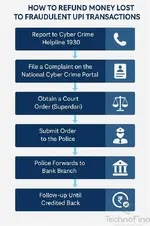With the increasing use of UPI, cases of online fraud have become more frequent. Many victims give up hope of recovering their money, assuming it is lost forever. However, there is a proper legal process that can help victims retrieve their funds if they act quickly and follow the right steps.
I went through this process myself after two fraudulent transactions of ₹5,000 and ₹25,000 were carried out from my account. Here is exactly how I managed to get my money back.
⸻
1. Report Immediately to the Cyber Crime Helpline (1930)
The first step is to call the cyber crime helpline 1930 as soon as you realize you have been defrauded. Provide them with all relevant details such as transaction IDs, screenshots, and any communication you had with the fraudster.
Once the complaint is logged, the cyber crime team will block all accounts involved in the transaction chain. For example, if you transferred money to a fraudster and they subsequently transferred it to other accounts, all those accounts will be frozen.
⸻
2. Filing a Complaint on the National Cyber Crime Portal
After your initial call, your complaint will also be registered on the National Cyber Crime Reporting Portal. This platform will automatically assign your case to the police station that has jurisdiction over your area.
The police will verify the details and will request you to initiate the “Superdari” process if the fraudulent amount is successfully placed on hold.
⸻
3. Obtain a Court Order (Superdari)
To release the blocked funds, you must obtain a court order (Superdari order) from your local district court. For this step, it is advisable to hire an advocate who is familiar with such cases.
Your lawyer will file the necessary petition, and once the order is granted, it will direct the concerned bank to transfer the held amount from the suspect’s account back to the victim’s account.
They will charges 2,000-4,000. depends upon amount of fraud transactions.
⸻
4. Submit the Court Order to the Police
After receiving the court order, submit it to the investigating police officer. The police will then forward this order to the concerned bank branch and its nodal officer.
⸻
5. Internal Bank Processing
This is where most delays happen. In my case, the police sent the court order to the bank branch, but the branch failed to act. I had to follow up daily and escalate the matter to multiple levels:
• Branch Manager
• Nodal Officer
• Zonal Officer
Eventually, I learned that the branch must forward the order to the bank’s Zonal Surveillance Team. The Zonal team then sends it to the Bank’s Cyber Cell, which removes the hold from the suspect’s account. Once this is done, the branch transfers the amount to the victim’s account.
⸻
6. Be Persistent
Though the official process is straightforward, practical delays are common. In my case, it took nearly four months of continuous follow-up. Persistence is crucial because sometimes bank officials are unaware of the exact procedure, and without pressure, your case might be left pending.
⸻
Key Takeaways
• Report the fraud immediately by calling 1930.
• File a complaint on the National Cyber Crime Portal.
• Obtain a court order (Superdari) with the help of a lawyer.
• Submit the order to the police and ensure it reaches the correct bank department.
• Follow up regularly with the branch, nodal officer, and zonal office until the amount is credited back.
⸻
Final Outcome
After months of follow-up and coordination with multiple bank levels, I successfully recovered both fraudulent transactions of ₹5,000 and ₹25,000.
If you are a victim of UPI fraud, do not give up. There is a legal and procedural way to reclaim your money, but it requires prompt action and persistence.
I went through this process myself after two fraudulent transactions of ₹5,000 and ₹25,000 were carried out from my account. Here is exactly how I managed to get my money back.
⸻
1. Report Immediately to the Cyber Crime Helpline (1930)
The first step is to call the cyber crime helpline 1930 as soon as you realize you have been defrauded. Provide them with all relevant details such as transaction IDs, screenshots, and any communication you had with the fraudster.
Once the complaint is logged, the cyber crime team will block all accounts involved in the transaction chain. For example, if you transferred money to a fraudster and they subsequently transferred it to other accounts, all those accounts will be frozen.
⸻
2. Filing a Complaint on the National Cyber Crime Portal
After your initial call, your complaint will also be registered on the National Cyber Crime Reporting Portal. This platform will automatically assign your case to the police station that has jurisdiction over your area.
The police will verify the details and will request you to initiate the “Superdari” process if the fraudulent amount is successfully placed on hold.
⸻
3. Obtain a Court Order (Superdari)
To release the blocked funds, you must obtain a court order (Superdari order) from your local district court. For this step, it is advisable to hire an advocate who is familiar with such cases.
Your lawyer will file the necessary petition, and once the order is granted, it will direct the concerned bank to transfer the held amount from the suspect’s account back to the victim’s account.
They will charges 2,000-4,000. depends upon amount of fraud transactions.
⸻
4. Submit the Court Order to the Police
After receiving the court order, submit it to the investigating police officer. The police will then forward this order to the concerned bank branch and its nodal officer.
⸻
5. Internal Bank Processing
This is where most delays happen. In my case, the police sent the court order to the bank branch, but the branch failed to act. I had to follow up daily and escalate the matter to multiple levels:
• Branch Manager
• Nodal Officer
• Zonal Officer
Eventually, I learned that the branch must forward the order to the bank’s Zonal Surveillance Team. The Zonal team then sends it to the Bank’s Cyber Cell, which removes the hold from the suspect’s account. Once this is done, the branch transfers the amount to the victim’s account.
⸻
6. Be Persistent
Though the official process is straightforward, practical delays are common. In my case, it took nearly four months of continuous follow-up. Persistence is crucial because sometimes bank officials are unaware of the exact procedure, and without pressure, your case might be left pending.
⸻
Key Takeaways
• Report the fraud immediately by calling 1930.
• File a complaint on the National Cyber Crime Portal.
• Obtain a court order (Superdari) with the help of a lawyer.
• Submit the order to the police and ensure it reaches the correct bank department.
• Follow up regularly with the branch, nodal officer, and zonal office until the amount is credited back.
⸻
Final Outcome
After months of follow-up and coordination with multiple bank levels, I successfully recovered both fraudulent transactions of ₹5,000 and ₹25,000.
If you are a victim of UPI fraud, do not give up. There is a legal and procedural way to reclaim your money, but it requires prompt action and persistence.





